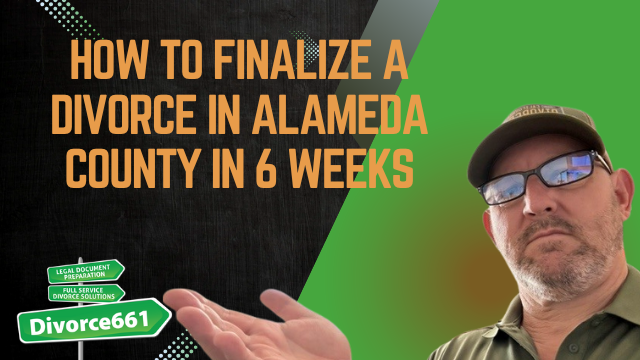How to Finalize a Divorce in Alameda County in 6 Weeks
I’m Tim Blankenship from Divorce661. In my video I explain a fast, practical path to finalizing an amicable divorce in Alameda County — often in just 4–6 weeks of paperwork preparation — even though California law requires a six-month waiting period before the judgment becomes final.
Why the “six-month” rule doesn’t mean six months of paperwork
California requires a minimum six-month waiting period between the date your spouse is served (or signs a Notice of Acknowledgement of Service) and the date the divorce becomes final. That six-month clock starts early, but it doesn’t mean you must wait to complete every step of the process. If you get all of the documents done and filed quickly, the court will simply hold your judgment until the waiting period expires.
In short: you can complete and submit everything in weeks, then wait out the remaining days for the final date.
How couples complete the paperwork in 4–6 weeks
The key is to get organized and move deliberately through each required step. Below is the typical sequence I use with amicable clients to finish the paperwork fast.
- File the petition.Start the case by filing the petition for dissolution with the court. This begins your case record while allowing you to work on the remaining items right away.
- Serve your spouse (or obtain signed acknowledgement).The six-month waiting period officially starts when your spouse is served or signs an acknowledgement of service. Arrange service promptly so the clock can begin while you finish the other steps.
- Complete financial disclosures early.Financial transparency is essential. Disclosures typically include income information, lists of assets and debts, and supporting documents like pay stubs and bank statements. Completing these early prevents delays and makes settlement negotiations smoother.
- Draft the settlement agreement.When both parties agree on division of property, support, and other issues, put those terms into a written settlement agreement (Marital Settlement Agreement). Clear, signed agreements avoid surprises and eliminate the need for contested hearings.
- Prepare and submit the judgment package.Assemble the judgment, proposed order, and all required attachments. Submit everything to the court once the settlement is signed so the court can enter the judgment on or after the six-month date.
Estimated timeline
- Week 1: File petition and arrange service.
- Week 1–3: Exchange and complete financial disclosures.
- Week 2–4: Negotiate and sign settlement agreement.
- Week 3–6: Prepare and file the judgment package with the court.
Real client example: 31 days to paperwork completion
A recent Alameda County client wanted the fastest possible path. We filed their petition, served the spouse, completed disclosures, negotiated and signed the settlement, and submitted the final judgment package — all within 31 days.
Their divorce is now set to finalize on day 183, like clockwork.
That client still waited the statutory period for the judgment to become effective, but because everything was submitted early, there were no court delays, disputes, or extra hearings to extend the timeline further.
Why early submission is the smartest move for amicable divorces
- It minimizes surprises — the court simply enters the judgment when the waiting period ends.
- It avoids the need for contested hearings and multiple court appearances.
- It reduces the risk that missing disclosures or unsigned documents will cause new delays.
- It gives you certainty and a clear final date you can plan around.
Checklist: What you need to complete quickly
- Filed petition for dissolution
- Proof of service or signed acknowledgement
- Complete financial disclosures and supporting documents
- Negotiated and signed settlement agreement
- Prepared judgment package and proposed order
- Filed judgment package with the court
How Divorce661 helps
At Divorce661 we provide a remote, flat-fee, full-service solution focused on amicable divorces in Alameda County. We handle filing, service coordination, disclosure assistance, settlement drafting, and court-compliant e-filing — so you avoid court visits and administrative delays.
If you want the paperwork completed in 4–6 weeks (so the judgment can be entered automatically after the statutory waiting period), we can manage the entire process for you and make sure everything is court-ready.
Ready to get started?
If you’re interested in a fast, efficient divorce process, schedule a free consultation at Divorce661.com. We’ll review your situation, explain the timeline, and outline how we can get your paperwork submitted quickly so you can move forward.
Visit: Divorce661.com
Summary
The six-month waiting period in California does not require six months of paperwork. By filing early, serving promptly, completing disclosures, and submitting a signed settlement and judgment package, you can have everything done in as little as 4–6 weeks — then simply wait for the statutory final date. Acting quickly and preparing everything thoroughly is the best path to a smooth, predictable finalization.










